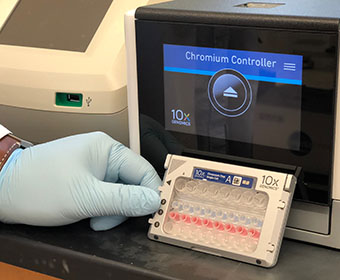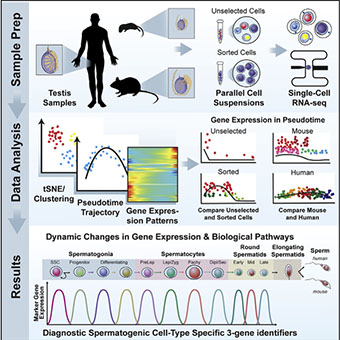(Nov. 8, 2018) -- Millions of couples who have trouble conceiving may get relief from new research led by scientists at UTSA. The researchers have developed a high-resolution genetic map showing how men produce sperm cells. Their effort could help address genetically based challenges with male fertility, a major cause of conception problems.

The UTSA Genomics Core center uses the 10x Genomics Chromium instrument which only requires small fragments of DNA to assist researchers with the ability to interpret gene variants that are associated with specific traits or the progression of disease.
The researchers’ findings reveal detailed information about which genes are turned on or off in stem cells that ultimately grow into sperm cells. This data could give doctors crucial insight into the development of sperm in a patient, a perspective that was lacking up until now.
UTSA researcher Brian Hermann says the new knowledge could be a game changer for uncovering what can go wrong in men who suffer from infertility.
“We took a new, cutting-edge approach down to the level of individual cells to understand all the changes in which genes are used to make sperm in the testicles. That previously had not been possible and impedes progress toward a cure for male infertility,” said Hermann, a biology professor and director of the UTSA Genomics Core.
The findings appear in the November 6 edition of the scientific journal, Cell Reports. Professors Hermann and John R. McCarrey led the group, which included researchers at UTSA and across the country.
Together, the team built a comprehensive digital library of the cell types required for sperm production in mice and men. They examined more than 62,000 cells and identified 11 different gene expression profiles; their work even uncovered rare and new cells for which little data was previously reported. The research, which began in early 2014, was supported by the Kleberg Foundation, the Hurd Foundation and the National Institutes of Health (NIH).
According to the NIH, reproduction issues in males contribute to at least half of infertility cases among couples. Many cases of male infertility are treated with medication. Some even require surgical procedures. Yet, in almost half of these same cases, the reasons for male infertility are unknown.

UTSA’s digital roadmap was constructed using the sequencing of genes expressed in germ cells. The researchers used high-tech machines which allow scientists to examine tens of thousands of individual cells and produce the library of genes expressed in each cell in one to two days. The method also employed cutting-edge bioinformatics, data analytics that decode gene expression data generated from the cells.
UTSA’s individualized approach to profiling gene expression at the single-cell level is what makes this work different. Previous methods have relied on analyzing groups of cells, but when they are bundled together in experiments, the differences among the individual cells are averaged and therefore obscured. Hence, UTSA’s new approach provides important data that can help uncover the biology underlying how sperm are produced and what may go wrong in men who suffer from infertility.
“This is how we find the needles in the haystack,” said Hermann. “We weren’t previously able to separate different cells with different functions, so in order to understand exactly how they are different, we looked at individual single cells, instead of the typical way of grabbing them all in bulk as a group.”
UTSA’s new digital gene expression library offers many scientific applications. It could help improve clinical diagnoses in men with infertility because their gene expression “signatures” will be different than those in the normal men now described in this new database. The UTSA resource can also provide a foundation to help innovate the next generation of male contraception and to even potentially develop sperm outside the body.
The researchers are hopeful that the methodology can also be applied to other biological processes in the body in order to uncover new information on which to base novel approaches to diagnose, treat or prevent a wide variety of diseases.
“It’s been a dream for decades to take the most primitive cells in the testis and convert them into sperm in a petri dish, yet this has never worked,” said Hermann. “If anyone is going to generate sperm cells in a dish, they’d want to know how similar those cells are to those that occur naturally in the body. The data we have generated now provides a reference library for comparison.”
The UTSA Genomics Core is one of the leading centers in the country and the only center in South Texas that assists in genomics profiling of single cells.
Connect with UTSA online at Facebook, Twitter, YouTube, Instagram and LinkedIn.
UTSA Today is produced by University Communications and Marketing, the official news source of The University of Texas at San Antonio. Send your feedback to news@utsa.edu. Keep up-to-date on UTSA news by visiting UTSA Today. Connect with UTSA online at Facebook, Twitter, Youtube and Instagram.
Huddle Against Hunger is a fundraising competition with Texas State that benefits our Roadrunner Pantry. Donations this week will help UTSA earn additional prize monies provided by RBFCU.
In-Person and VirtualJoin UTSA Libraries for an update on federal public access policies and how the library can assist with compliance.
Virtual EventWe invite you to join us for Birds Up! Downtown, an exciting welcome back event designed to connect students with the different departments at the Downtown Campus. Students will have the opportunity to learn about some of the departments on campus, gain access to different resources, and collect some giveaways!
Bill Miller PlazaThere are many citation managers. Which one is right for you? This workshop will explain what a citation manager is and how it can help you organize your citations, insert citations as you write your paper, and generate your bibliography.
Virtual EventPubMed is an essential database for anyone conducting biomedical or health-related research. This workshop will teach attendees how to effectively navigate this free resource and locate peer-reviewed articles using advanced search features, MeSH subject headings, and Boolean operators.
Virtual EventIn this hands-on workshop, participants will learn to setup an EndNote library, save references and PDFs, and automatically create and edit a bibliography. Attendees are encouraged, but not required, to have EndNote already installed on a personal computer.
Virtual EventJoin UTSA Libraries and Museums to learn more about the publishing discounts available for UTSA researchers. Current agreements include Elsevier, Cambridge University Press, Wiley, and more. Bring your questions and feedback for the library as we continue to pursue partnerships with publishers to reduce costs for our researchers.
Virtual EventThe University of Texas at San Antonio is dedicated to the advancement of knowledge through research and discovery, teaching and learning, community engagement and public service. As an institution of access and excellence, UTSA embraces multicultural traditions and serves as a center for intellectual and creative resources as well as a catalyst for socioeconomic development and the commercialization of intellectual property - for Texas, the nation and the world.
To be a premier public research university, providing access to educational excellence and preparing citizen leaders for the global environment.
We encourage an environment of dialogue and discovery, where integrity, excellence, respect, collaboration and innovation are fostered.